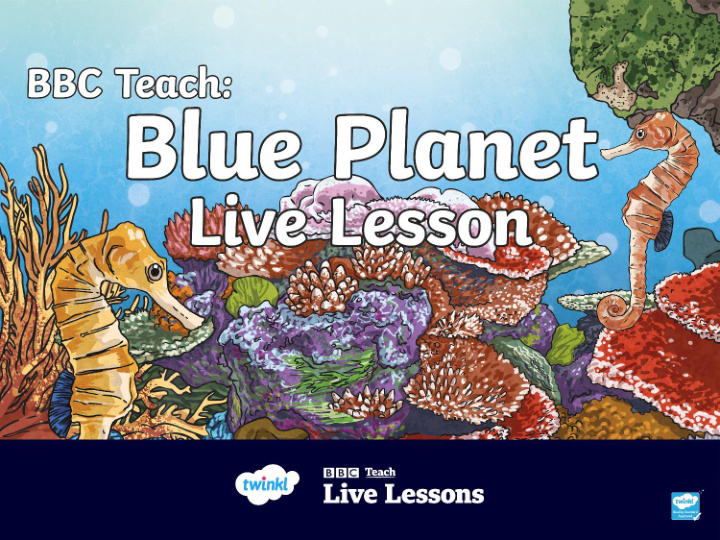



Our Beautiful Blue Planet In the seas and rivers, there are lots of 3 Fascinating Facts tiny organisms called plankton . Lots of living things eat these plankton, but On Earth, there’s more marine when mobula rays feed on them, the 1 life than people. plankton lights up, turning fluorescent. Plankton are really small, but are a 4 All of our oceans are connected. really important part of the Earth’s 2 Sharks are sea creatures that oxygen supply. All of the plankton, seaweeds and sea grasses make as don’t stay in one place. They swim around and move to much oxygen as the forests and different oceans. grassy plains on Earth.
What Are We Doing? As humans, we are causing harm to our blue planet in these ways: Overfishing This is when too many fish are caught. If people catch too many fish, this affects many living things in the ocean. Let’s Look! Living things all need to survive. Some creatures that live in the ocean eat plants, others eat different living things. This is called a food chain. If one part of the food chain is broken (like a type of fish being removed from the ocean by overfishing), then other things may not survive because they won’t have food.
What Are We Doing? Plastic pollution This is when plastic gets into the seas and pollutes, or harms, the living things. When a person eats a prawn which has swallowed Let’s Look! plastic, that person has also eaten some of the plastic. Plastic is a very useful material, but it is very hard to get rid of. When a • plastic straw is not needed anymore, it needs to be burnt or broken down. It can’t be recycled as easily as paper, so many people throw them away. They end up as landfill and in the sea. Big pieces of plastic in the sea, like plastic bags, can harm the creatures as • turtles and dolphins can get tangled in them. Sometimes, sea creatures eat plastic as they mistake it for food. If a whale • eats plastic, it can’t work its way though the body, so it would stay in the whale’s stomach, meaning there wouldn’t be enough room for food. Plastics can also start to break down into tiny pieces in the sea; this means • that plastic gets into our food chain and lots of living creatures start to eat plastic, even you and me.
We Need to Stop! People are causing lots of harm to our oceans and their living things. This When these harmful gases rise up into the air, they get trapped in the layer means that our weather, or climate, is changing. Harmful gases are very protecting our Earth from the Sun (called the atmosphere ). When the Sun damaging to our climate . These gases are produced by cars, vehicles and the shines onto the layer of gases, they get hotter and hotter and heat up our Earth factories that make some of our toys. too much. This is called global warming .
We Need to Stop! Global warming isn’t good for our Earth as it heats everything up. It causes ice to melt in the Antarctic and sometimes this causes floods in other parts of the world. Flooding and rising sea levels means that beaches become smaller. This poses a danger to many animals, such as the loggerhead sea turtle, which lays its eggs in a nest on the beach. Additionally, the nests need to be the perfect temperature, as this affects whether the turtles will grow to become male or female. If the temperature keeps rising, more female turtles will be born than males. This increases the risk of this wonderful, already vulnerable species, becoming extinct.
How Can You Help? There are lots of ways we can help protect our beautiful blue planet: Recycle things, rather than throw them away. Stop using lots of plastics that could end Eat sustainable fish (that up in the seas (even wet means fish that isn’t wipes can contain small allowed to be overfished, so amounts of plastic). we don’t run out). Help spread the message about looking after our oceans and recycling.
How Can You Help? Can You Make a Recycled Plastic Sculpture? Help spread the word in your community that we need to stop polluting our beautiful blue planet. You will need to write a Plastic Amnesty Poster . Next, you will need to design a sea creature that people’s actions are putting in danger. You will make this sea creature out of the recycled plastics, to make everyone who sees it think about what harm plastic is causing.
Inspiration Artists have already been making sculptures out of recycled plastic. Take a look at these for inspiration. “ 270518-003 CPS ” by [ Chris Sampson ] is licensed under CC BY 2.0 “ Dolphin made from Reclaimed Plastics ” by [ Larry Koester ] is licensed under CC BY 2.0 “ Washed Ashore: Art to Save the Sea ” by [ IIP Photo Archive ] is licensed under CC BY 2.0 “ Trash Talking Turtle ” by [ Sheila Sund ] is licensed under CC BY 2.0 “ Washed Ashore: Art to Save the Sea ” by [ IIP Photo Archive ] is licensed under CC BY 2.0
BBC Teach Blue Planet Live Lesson Partnership Activity When writing your poster, remember: Choose a catchy title. • Use short, carefully chosen • sentences. Make it eye-catching. • Add key information, e.g. where • people can donate their plastic/the date the amnesty finishes. • Add your own attention-grabbing picture.
BBC Teach Blue Planet Live Lesson Partnership Activity Complete your sculpture design sheet. Take time to think and write about what key message your sculpture will show everyone.
Recommend
More recommend